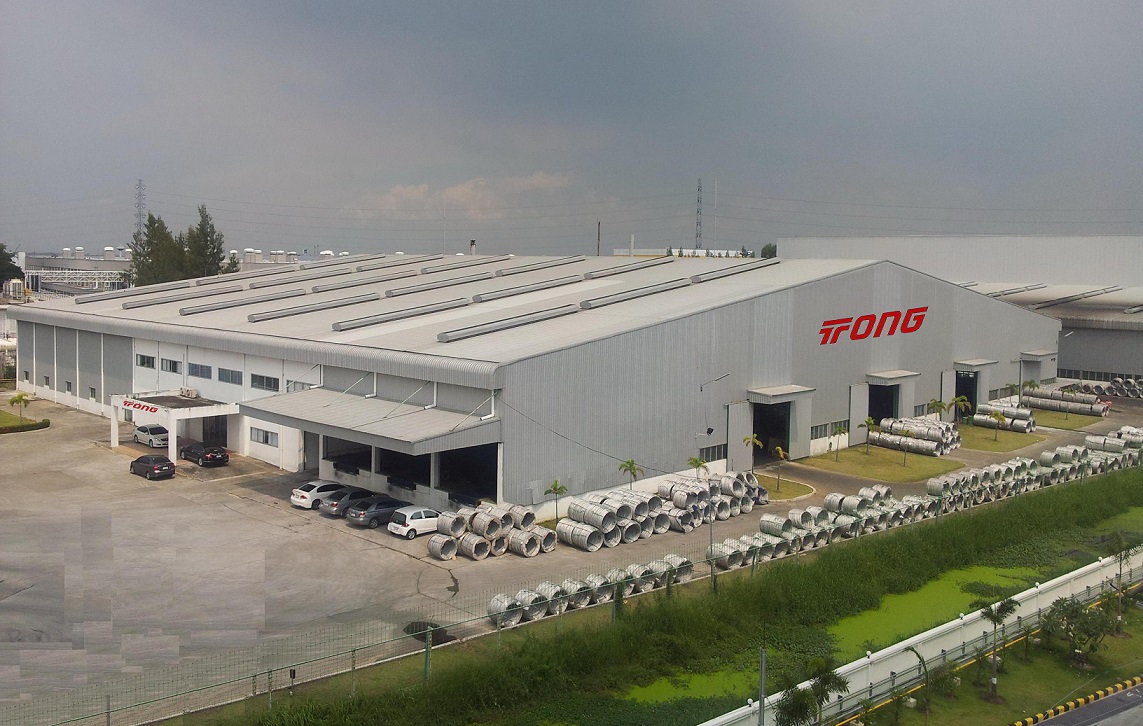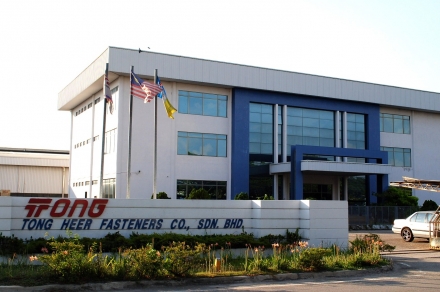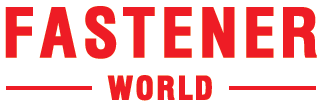
Industry Activities






TONG Group is well known for manufacturing stainless steel fasteners and its business following the group’s continuous strategies has been successfully done and expanded to many areas around the world. It affiliated enterprises includeing Winlink Fastener (Taiwan), Tong Ming (China), Tong Heer Fasteners (Malaysia), and Tong Heer Fasteners (Thailand), which are all independently operated and publicly traded. Ms. Wen-Ling Ko, president of Winlink Fastener and the spokesperson of TONG Group, shares with us the Group’s operation network and market analyses.
1. Tong Heer has been through many challenges and created several high peaks in its operation since its founding in Malaysia in 1989. Can you talk about the brief history, mission statement, and management strategy of TONG Group?
In 1990s it was time for us to expand factories to satisfy more demand, and while considering the location, industrial environment, and low-birth rate of Taiwan, we though that the labor force would definitely be one of the factors influencing fastener manufacturing. In order to correspond with the government’s “Going Southward” policy at that time, Tong Heer was lucky to have a chance to know further about Thailand, Indonesia, and Malaysia. According to its evaluation, Penang (Malaysia) was then a city with a highest population density of Chinese origin. In a business trip to the local market, Tong Heer’s President and Vice President were surprised to find that the Indian taxi driver could even communicate with them in Mandarin Chinese and some Minnan dialect, so they immediately determined to set up their operations in Malaysia, because “language, culture, and labor force” are all critical elements for setting up overseas operations. In Malaysia, Tong Heer does not have to worry about the language issue and its employees don’t even need to study but with good ability in Chinese, Minnan, Malaysian, and English. Compared to other neighboring countries, Malaysian political and economic development are stable.
Tong Heer does not focus on the domestic Malaysian market but its favorable export policies. With the continuous national development, though the labor cost is not the advantage of Malaysia, Malaysian government has quite open and diverse regulations for labors from foreign countries, such as Bangladesh and Cambodia, making Malaysia the best manufacturing base for Tong Heer.
2. What is Tong Heer’s Marketing Strategy?
After Tong Heer set up its Malaysian factory in 1989, it again set up the 2nd oversea manufacturing factory in Thailand in 2004 with new production lines and target markets. Now it has had two factories in Thailand. Our marketing strategy is very simple. Considering that there are different favorable export duties in different countries, we will determine our export location based on our target market, which is a very important condition when we select the manufacturing base. For example, Tong Heer Fasteners (Malaysia) focuses on Europe and Northeastern Asia, while Tong Heer (Thailand) focuses on European and U.S. markets.
3. Tong Heer was once awarded “the Most Valuable Stock in the Industrial Market” and established Tong Heer Aluminum after reporting years of good results. Can you talk about the entities and operations of the Group? The Group’s annual production? The turnover in most recent years?
Tong Heer was awarded due to its high currency and net worth ratios as well as a low loan ratio, and a well-organized financial system. Tong Heer Aluminum is an aluminum extrusion and framework company we acquired in Malaysia with over 50% ownership of its stocks. This company is managed by the original team and it did perform well in terms of profit. Either Tong Heer Fasteners (Malaysia) or Tong Heer Fasteners (Thailand) has the annual production of 20-30 thousand tons and the combined turnover of two factories remains at a NTD 6 billion level.
4. Tong Heer’s stainless steel screws/nuts can be used in various areas incl. solar power, petrochemical, mechanical assembly, food processing machines, telecommunication, and construction. How can the company control the quality and prices of products at a time and strengthen the sales?
As the world’s largest stainless steel fasteners supplier, we adopt the strategy of group decision and mutual purchasing of stainless steel wire, which is not only favorable to keep our cost within a certain level as well as control the quality. On the other hand, hiring from local markets is also favorable to the localization of Tong Heer. With more and more well-trained staff in the company, its Malaysian factory can accept orders for high-end products and its Thai factory accepts orders for general products in bulky volumes. Such product range and market segmentation are good for the Group to expand and deploy in the stainless steel fasteners market.
As there still exist many uncertainties around the world, Tong Heer expects to utilize its current advantages to maintain its market share. One of the most important points is, endless competition will sometimes weaken our advantage. Tong Heer is characteristic of its harmonious way of competition and making its customers opt for their own partners.
5. What factor do you think is the most important for stabilizing a company’s operation?
“Employees” is the most important factor for stabilizing a company’s operation. The company owner has the right and commitment to determine what the next step is. However, if a company would like to go steadily forward, most of the time it must rely on the devotion and efforts of employees. The company has to provide employees with a sense of safety, so the employees will be willing to fight for their company, which is more meaningful and powerful than the president or general manager fighting for his company alone.
I currently read a book “Trust” by Francis Fukuyama, which emphasizes the importance of trust. I think every action has to rely on trust, otherwise, no great business can be achieved. In terms of today’s process of succession, one who cares only about himself won’t be the selected anymore, instead, only the combination of talents from various areas can help a company achieve the best result of sustainable operation.
6. What are Tong Heer’s expectations and plans to the future? How will it make the most of capital and talents?
There will not be oversupply of stainless steel products in the future and the supply will definitely continue to grow. We are planning to set up our 3rd operation in Asia and hopefully the construction can be finished within 3 years. Any investment and market deployment of Tong Heer are done with the aim of sustainable operation. Accordingly, we are always discreet in the evaluation of manufacturing bases, advantages in the market, and even the re-investment of factories and expect to complete the market deployment before the demand appears.
Meanwhile, “employees” is very critical for the survival of Tong Heer, as what we are thinking is, how we can create the value for the company as operators, and this value is not based on lower cost to create conditions for a company’s survival. I think this is very important, but many companies oftentimes neglect it.
7. What has been the key factor for your company to enter the supply chain in recent years?
It is not only about being the first one, most of the time it is about how you can become one that your competitors cannot defeat. Fasteners are general but sophisticated products. When others could not do it, we did it. Of course, the acquisition of the above mentioned “enterprise culture” and “raw materials (stainless steel)” are quite important. What is “sophisticated”? To be concrete, it means that we can evaluate and adjust our order plan and get the most useful data analysis for ourselves and customers based on the profit structure of every order. I think, many companies may know whether an order is profitable or not, but they may not know the exact reason.
8. How do you see the competitive edge and potential of the global fastener market? If you are asked to select the most valuable emerging market or industry for future development, what will you select and why?
The growth in Asia compared to others around the world is still very significant and its labors are comparatively young. Indonesia and Cambodia, for example, both show potential for development.
9. With some favorable conditions such as economic recovery, 2014 is said to be a profitable year and 2015 currently shows signs of slight demand decline and slow growth, what is your opinion about this? Going forward, how do you see the development of the global stainless steel fasteners industry in 2016?
For Tong Heer, it is hard to say which year is profitable, as since the founding of Tong Heer, it has been continuously and steadily growing. Looking to the future, stainless steel products are very likely to replace carbon steel products, so stainless steel fasteners continue to maintain a 3% annual growth and Tong Heer’s goal is to continuously maintain its role as the largest supplier in the market and provides the best service.
10. In the future supply/demand market, who do you expect to cooperate with? Do you have any suggestion for your cooperative companies?
Having the same perception as other century-old European/U.S. enterprises, Tong Heer thinks that cooperative partners have their own value and we care about them very much and hope that they can treat us in the same way. To say it simply, we welcome partners caring about sustainable operation to cooperate with us. Per my opinion, “trust” is able to calculate. With the same products from different suppliers, customers will finally determine which one to cooperate with based on “trust” as they know such difference could help them ensure the orders.
11. Is there anything else for the fastener industry you would like to say?
Taiwanese fastener industry has demonstrated a significant progress in recent years. They started to focus on different markets for creating their own value. For example, Sumeeko, San Shing, and Boltun are all excellent companies. Currently we see Taiwanese large companies are playing their roles really well; medium-size companies are getting exquisite; however, small-size fastener companies seem to still cannot find their own positions in the market. As a result, I suggest that small-size fastener companies should be more flexible and try to cooperate with other medium/large-size companies, after that, there may be better development for them.

Subscribe











